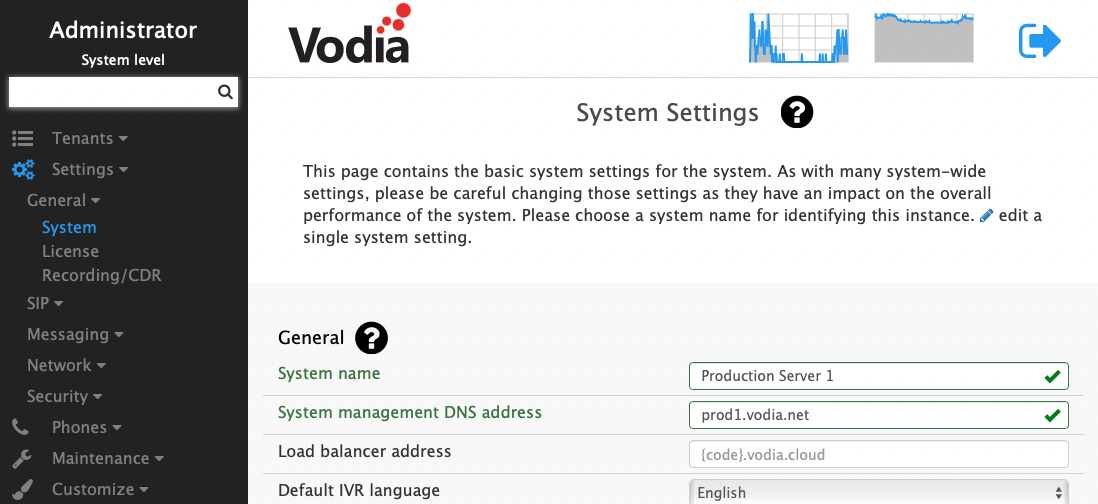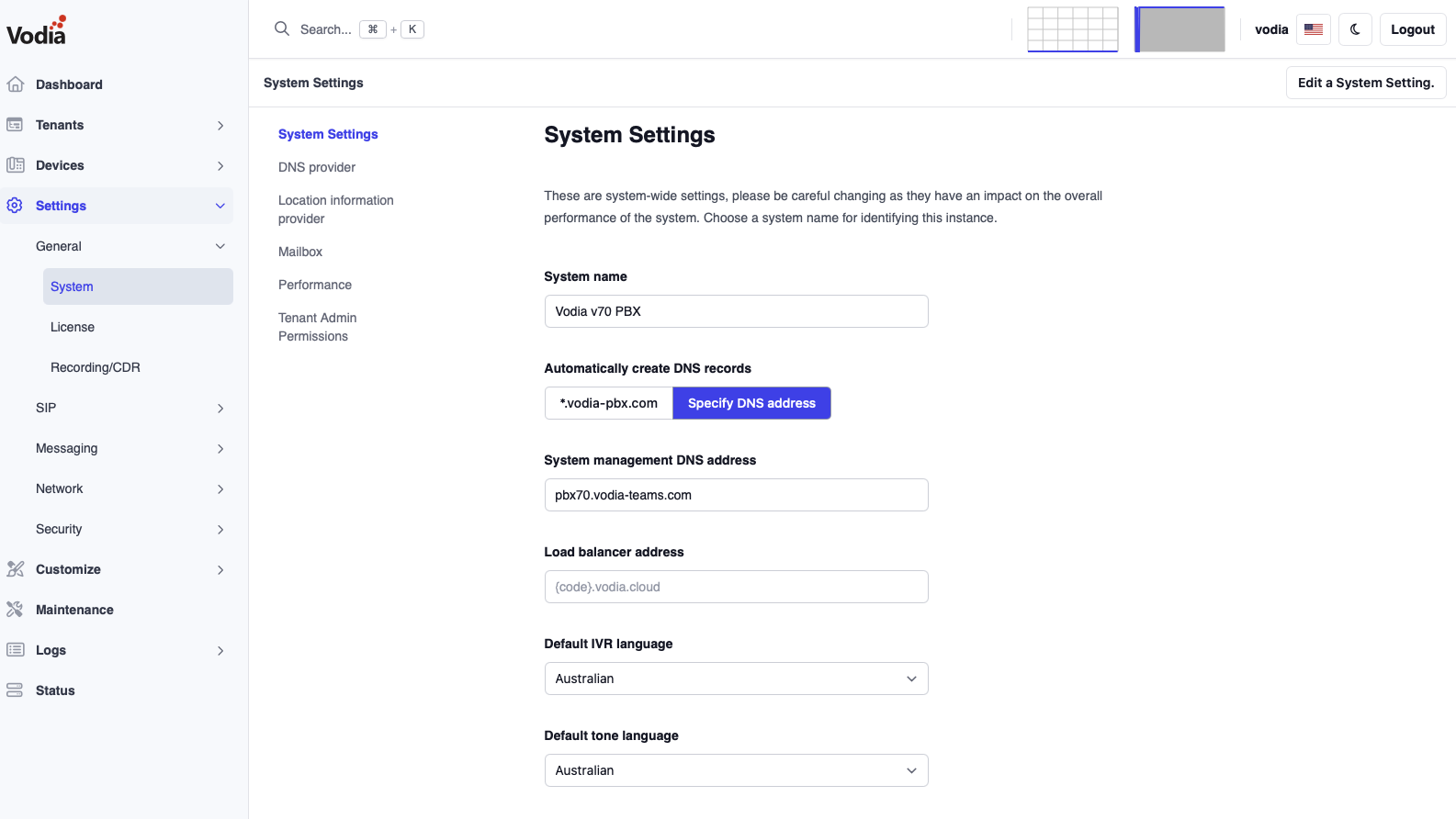System Settings
General system settings can be changed by the system administrator on the page for general system settings.
- Version 69
- Version 70


The PBX keeps most of the general system settings in a file called pbx.xml. This file is essential for the operation of the server and this file should not be edited with a text editor. Instead of editing this file directly, you can instead select the setting that needs to be changed on the general system settings page by clicking on the pen symbol in the header, which will bring up a dialog for editing the content of the setting. This dialog contains all settings that are available in the file.
Explanation of the Settings
General
System Name: This field allows the administrator to set a name for the system. The name is used in several places to identify the system. For example, when the system sends out emails with system performance information, the system name will be placed into the subject line of the e-mail.
System management DNS address: This is the address under which the system administrator can log in. If set and when using the ACME protocol to issue certificates, the PBX will attempt to generate a X-509 certificate for this address.
Load balancer address: The PBX can be operated behind a load balancer, either to make the system manageable behind a firewall or to operate the PBX in a cluster. The address where the load balancer is located needs to be entered in this field.
Default IVR Language: This setting represents the language that is used for voicemail and IVR prompts. If the desired language is not available, it might have to be installed as described in Installing Languages.
Default Tone Language: This setting allows you to control the ringback and busy tones that a caller hears during voicemail prompts and IVR interaction. The files that influence this setting are ringback.wav and busy.wav. These files are located in the audio_xx directory. The xx represents a language identifier code.
Default Web Language: This setting controls the language used on the web interface.
Time Zone: The Time Zone setting is used to set the local time zone. It influences the time that appears on a user’s mailbox messages, telephone display, and voicemail. The system is capable of dealing with several time zones at once, making it possible for every user to select his or her own time zone.
Time format: In certain areas such as emails the system needs to know how to present time. This setting controls weather to use 12 or 24 hour format.
Date format: Same for the date format.
Name format: Some areas prefer to present the first name first, and other prefer to present the last name first. This setting controls this.
Default country code: The default country code can be set here for the whole system as an admin which will apply to each tenant if it's a multi-tenant system. Alternatively, it can also be set on per tenant basis inside the general settings for the tenant.
ACME Directory URL & DNS provider: Instead of purchasing and manually installing certificates (described in Admin Security), the system can automatically generate certificates.
- The PBX supports generating X.509 certificates using the ACME protocol through HTTP and DNS challenges. When using the HTTP challenge, the system must be on a public IP address and it must use port 80 . When using the DNS challenge, the DNS must have access to the DNS provider (currently DNSMadeEasy is supported).
- When adding a new tenant, the PBX will attempt to create the DNS entry for the new tenant and issue a certificate for the domain name. A few days before the certificate expires, the PBX will then attempt to reissue the certificate. When a tenant gets deleted, the PBX will attempt to delete the DNS entry.
- It is also possible to define a DNS name for the system. The PBX will also attempt to generate a certificate for this DNS address, so that the management access to the system can be done through a properly encrypted HTTPS connection.
- If you've had the PBX with tenants having FQDN attached on them, and if you turn on this feature, these tenants will acquire the certificate as well.
- Also add the FQDN of the PBX to the "System management DNS Address" section under Admin → Settings → General → System
Location information provider : This feature enables the System admin to provide the location of it's users on all of it's tenants using Bandwidths's services. This service can be provided for PBX based on both Local and Cloud level.
Mailbox explanation prompt: This setting set the default for the mailbox explanation prompt.
Offer camp on: This is another setting that defines the system wide default for camp on.
Rewrite anonymous caller-ID: This setting makes it possible to assign anynymous callers a unique ID. For example, when this setting is set to 99900XXXXX the first caller will have the caller-ID 9990000001, the second 9990000002 and so on.
Automatically switch to T.38: This setting controls the system-wide when the system should switch to the T.38 protocol.
Performance
Maximum Number of Calls: This setting defines the number of simultaneously calls allowed by the system. Because every call requires a certain portion of the available CPU, allowing too many calls will affect the quality of all ongoing calls. By limiting the number of calls on the CPU, you can reject calls that would otherwise potentially degrade overall performance. On modern PCs, 100 or more calls can run on one computer; however, on an embedded system, you will probably have much less CPU power and thereby increase the probability of running out of CPU power if you allow that many calls. If this field is left blank, the key in the system will limit the calls, or the CPU limitation, when reached, will limit the calls. Process Affinity Mask: This field allows the administrator to assign a particular CPU to the pbxctrl system process. When using a multiple-core CPU, the operating system has to assign processes to processors. By default, the operating system tries to balance out the load so that the overall system performance is as fast as possible. However, the disadvantage with this approach is that the whole process gets stuck for some time while moving the processes from one CPU to another. If during that time the CPU should play out media, it will come across as stuttering and be perceived as jitter coming from the system. In order to avoid this problem, bind the pbxctrl to one fixed CPU. Depending on the operating system, you can do this manually or you can ask the system processes to do this during startup. Changes to this field require a system restart. The processor affinity is represented as a bitmask, with the lowest order bit corresponding to the first logical CPU and the highest order bit corresponding to the last logical CPU.
If this field is left empty, the PBX will default the value to 1, meaning it will bind itself to CPU 0 (or core 0). In a 4-core (4 CPU) processor, if you want the PBX to bind itself to CPU0 and CPU3, then you have to set the value to 9 (binary value 1001 = 9). If you want it on all cores, then set this value to 15 (binary 1111 = 15). I think you get the point now. So, depending on the number of CPUs on the processor and your requirement, you can come up with a proper number to set here.
Media CPU usage limit (0-100): This setting was introduced in version 59.0 and above. It is used to set the CPU usage limit allowed to be given to the PBX manually from here. 80-85 should be good for a PBX that has over 5-10 calls per minute (Approximately). Maximum number of internal redirection: Is the number of count of a single call being redirected to other accounts within the PBX. Max. size of a configuration backup file: This setting allows you to establish the maximum size, in bytes, of the backup file. If your system has a lot of data to be backed up, increase this value. The backup feature through the web interface is used mostly in the appliances (in embedded systems where the file access is primitive). On other systems, it is advisable to use the OS file manager to do the backup. Max. number of concurrent registrations per extension: This setting controls how many user agents (i.e., phones) can be registered against an extension. This feature is useful if you want to restrict the number of phones that can be registered to an extension. If this field is left blank, the extension will have no limit. Minimum Registration Time (s): In a SIP environment, the registrar determines how long a user agent may be registered. Short registration times have a negative impact on the performance; however, it is critical that user agents stabilize quickly once they’ve lost their connection with the system. This setting defines the lower limit for the registration time. The default is 30 seconds. Maximum Registration Time (s): This setting is used to define the upper limit for the registration time. The default value is 360 seconds. Expiry for dialog subscriptions (s): This setting controls the duration for a dialog subscription, e.g. used in BLF subscriptions. On systems where there are a lot of BLF subscriptions, this setting defines the trade off between the refresh traffic and the speed for recovery e.g. when a phone lost connectivity with the system. UDP NAT Refresh (s): If the registering user agent is behind NAT, the system uses this setting to control the registration. The system registers agents that use the UDP transport layer only for a short time, so that the user agents will re-register quickly and keep the NAT bindings alive. Typically, the settings for UDP should be from 15 to 45 seconds since most NAT routers close ports after 60 seconds of inactivity. The default is set to 30 seconds. TCP/TLS NAT Refresh (s): This is similar to UDP NAT refresh setting. Since TCP/TLS connections do not need to refresh the bindings as often, a value of a few minutes are okay in most situations. The default is set to 180 seconds (3 minutes). Maximum call duration: This setting establishes an upper limit for the call duration. By default, the setting is 2 hours (7200 seconds), but you can increase it if you lean toward longer phone calls. This setting is crucial for keeping your call list clean, for example, if one mailbox talks to another mailbox or if a call does not drop properly, the system can automatically clean this up. Maximum ring duration (s): This setting determines the length of time the PBX will wait before it disconnects a call. Maximum voicemail duration: This setting controls how long a voicemail can be on the system. Setting this value too high will have an impact on the memory needed to store messages.
Tenant Admin Permission
These settings allow the administrator to restrict certain functions from the tenant admin:
Allow domain admin to change trunks: If this setting is disabled, the domain admin will be unable to change the trunks that have been configured for the domain. Allow domain admin to change dial plans: If this setting is disabled, the domain admin will be unable to change the dial plans that have been configured for the domain. Allow domain admin to create or change accounts: If this setting is disabled, the domain admin will be unable to create new accounts or change existing accounts. Allow domain admin to create or change ANI: If this setting is disabled, the domain admin will be unable to create new ANIs or change ANIs.